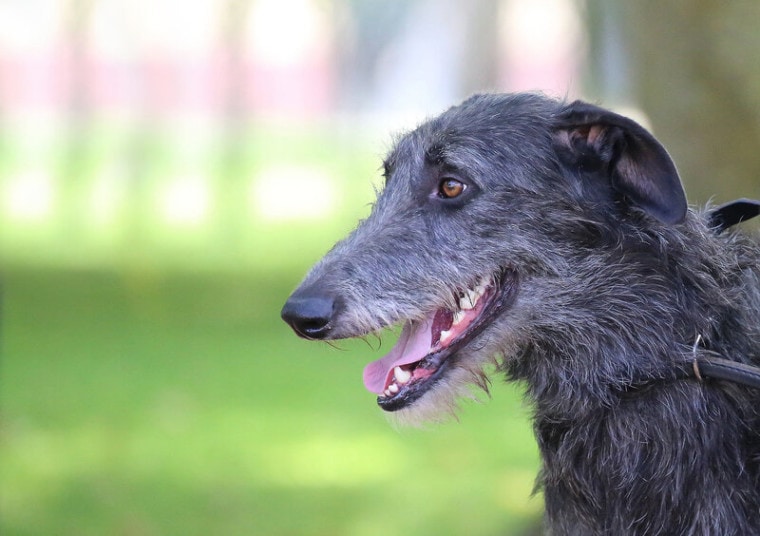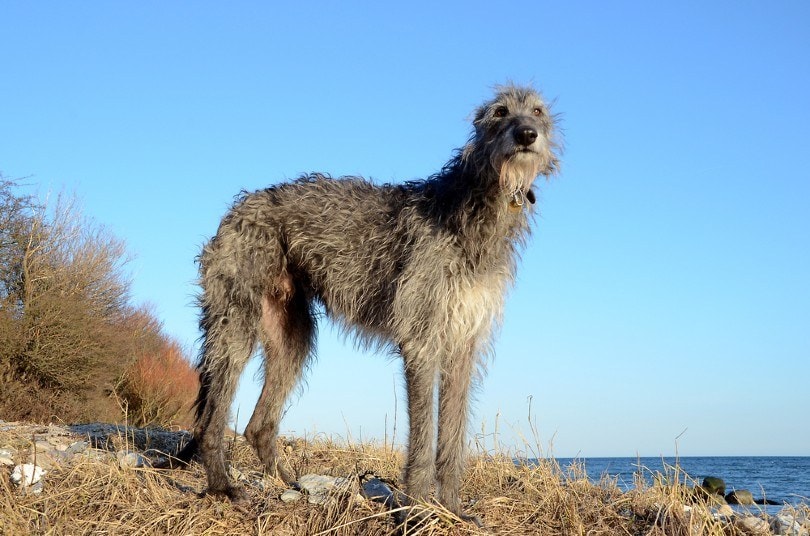
Click Below to Skip Ahead
The Scottish Deerhound is a large, purebred dog considered to be a gentle giant. Known as the Royal Dog of Scotland, this giant breed resembles the Greyhound and has much of the same temperaments: loving, loyal, gentle, and dignified. The Scottish Deerhound has also been called the Rough Greyhound, Scotch Greyhound, and the Highland Deerhound. This breed originated in Scotland in the 1500s, where they were used for hunting and chasing the Scottish Roe Deer. In Scotland during the 16th and 17th centuries, no one ranked lower than an earl could own one, and the breed was on the brink of extinction because of the restricted eligibility of ownership. In 1825, two brothers, Archibald and Duncan McNeill, started a breeding program to save them.
Breed Overview
Height:
30 – 32 inches (male), 28 inches and up (female)
Weight:
85 – 110 pounds (male), 75 – 95 pounds (female)
Lifespan:
8 – 11 years
Colors:
Gray, brindle, blue-gray, gray-brindle
Suitable for:
Active families, experienced dog owners, families wanting a large dog
Temperament:
Loving, loyal, gentle, polite, noble, dignified
In 1886 the American Kennel Club (AFC) registered the breed in the United States as members of the hound group. Today, they make excellent family dogs due to their loving and gentle disposition; however, if you’re looking for a Scottish Deerhound, you should be aware of their specific daily requirements before committing. In this article, we’ll take a closer look at this ancient breed to help you determine if it’s right for you and your family.
Scottish Deerhound Characteristics
 Scottish Deerhound Puppies
Scottish Deerhound Puppies
Before you search for your Scottish Deerhound, you must be prepared to have a giant dog as a companion. They are not suited for apartment living due to their enormous size, and they require a fenced yard to provide adequate exercise. Puppies can be quite energetic and destructive, and the breed is not recommended for the first-time dog owner. Patience and perseverance are key to training these dogs because they can be lazy, and if they don’t see anything in it for them, they will likely ignore your commands.
Nonetheless, these dogs love their human families and are affectionate and gentle. However, if you’re looking for a guard dog, this breed isn’t for you. While their size is intimidating, they will not bark at strangers and will greet them in a cheerful nature.
Temperament & Intelligence of the Scottish Deerhound
Despite their gigantic size, these dogs are affectionate and loving. They are never aggressive and are always polite and gentle. While they are intelligent, they can be on the stubborn side when it comes to training. If they are, say, “not in the mood” to obey commands, that just simply won’t. It takes patience and repetitious training, but if you’re persistent, your Scottish Deerhound will obey your commands.
The Scottish Deerhound’s size can be misleading if you want a large dog for protection. They will not bark at strangers and will greet anyone who comes to the door. They are friendly and easy-going, so don’t expect them to growl and bark if someone you don’t know is at your front door.
Scottish Deerhounds are not dogs that play fetch or tug-of-war. Instead, they love the thrill of a chase and love to run. These dogs need a large fenced yard to run in as much as they want. Even though they require moderate exercise, they still love to take a snooze and relax. Like the Greyhound, the Scottish Deerhound can be a couch potato.
Are These Dogs Good for Families? 👪
They make great family dogs and do well with children, given their sweet and gentle dispositions. Supervision is recommended in the presence of children because of their large size. During play, they may accidentally knock a small child down, but they’ll learn to be more careful around children with early socialization.
If you’re gone most of the time, the Scottish Deerhound is probably not your best bet for a canine companion. They don’t like to be left alone for long periods and may become restless and destructive as a result. You can take them on long walks, but trips to a dog park where they can run are ideal. If you’re a jogger, they make a great companion for your workout. If you take them on a walk, be sure to use a leash because they will give chase to anything that moves, including cars, making leash training a vital component in owning the Scottish Deerhound.
Does This Breed Get Along with Other Pets?
The Scottish Deerhound gets along with other pets for the most part; however, their strong prey drive may provoke a chase if you have cats or other small pets. Once the Scottish Deerhound learns that the animal is a family member, they’ll get along with them just fine. As a rule, they like the company of other large dogs, preferably.
Things to Know When Owning a Scottish Deerhound:
Food & Diet Requirements 🦴
Since this breed is of considerable size, they should eat 3 to 5 cups daily. We recommend dividing up meal times twice a day and feeding high-quality kibble for large dogs with a real protein as the first ingredient, preferably one that supports hips and joints. Large dogs are more prone to hip and elbow dysplasia, and food with glucosamine can aid in keeping their joints healthy. If you’re ever in doubt about how much to feed, consult your veterinarian to get an accurate amount for your particular Scottish Deerhound’s size.
Exercise 🐕
As we’ve mentioned, the Scottish Deerhound needs a moderate amount of exercise daily. Having a fenced yard is extremely necessary for this breed. They love to run and gallop, and they have tremendous speed. If there is a ball field or dog park in your community, take your Scottish Deerhound to one! They love an open field, but the area needs to be safe and enclosed. You should aim for at least 30 minutes of running and play twice a day. If you get a Scottish Deerhound and are looking for a perfect name, you could name it “Forest,” because then you could say, “Run, Forest, Run!”
It’s important not to overexert puppies, though. Their bones are still developing, and excessive exercise might damage the joints. You can walk them every day, but don’t walk for long periods at a time; approximately 2 miles a day should suffice. You can also let your puppy roam and run in a safe, enclosed area, such as your fenced backyard, and let them determine how much they want to run. However, always monitor to avoid over-exercising. After they are 18 months old, you can increase the amount of exercise safely.
Training 🎾
Training a Scottish Deerhound is somewhat different from other breeds. They are intelligent, but they also have a stubborn side. They are slow to train, but that’s because of their tenacious side. It takes an experienced dog owner to train this breed because consistency and persistence are key. They are eager to please their owners, but that doesn’t mean training will be a breeze. They are sensitive, so positive reinforcement is dire in training.
These dogs were bred for hunting, and that’s something they do exceptionally well; they don’t feel like they need commands from you. Stay the course and remain firm because, eventually, they will obey your commands. Expect for house training to take a few months, too. Crates come in handy for this purpose, but don’t leave your Scottish Deerhound crated all day and only use crates for training purposes.
Grooming ✂️
These dogs have a long, wiry coat that is weather resistant. They don’t shed too much, but weekly brushings with a slicker brush will keep the coat from becoming tangled. Their nails will need clipping every few weeks if not worn down naturally, and they only need baths to keep odor down or if they roll in something dirty.
Health and Conditions 🏥
While health conditions can strike any dog, there are a few conditions to watch out for in this breed.
Minor Conditions:
Serious Conditions:
Male vs. Female
One definite difference between the two genders is size and weight. Females can reach a height of 28 inches and up, whereas males can reach up to 32 inches. Females can weigh up to 95 pounds, whereas males can reach a whopping 100 pounds.
As far as temperament, there isn’t a difference. Both genders of this breed are gentle and laid back.
3 Little-Known Facts About the Scottish Deerhound
1. The Scottish Deerhound is the second tallest of all breeds.
There are similarities in appearance between the Irish Wolfhound and the Scottish Deerhound, but the Irish Wolfhound is the tallest. The Scottish Deerhound can reach a height of 32 inches, but the Irish Wolfhound reaches a height of 35 inches.
2. They excel in the Lure Coursing sport.
Lure Coursing is a sport designed explicitly for sighthounds. This sport involves a plastic bag that’s tied to a lure in a controlled, safe, and open field. Lure Crossing allows the dogs to focus on chasing their prey from sight instead of scent. The dogs are judged on speed, endurance, and agility. Given that Scottish Deerhounds were originally bred for chasing deer explains why they excel in this particular sport.
3. Sir Walter Scott considered the Scottish Deerhound “the most perfect creature of Heaven.”
Sir Walter Scott was a biographer, novelist, poet, and historian from Edinburgh, Scotland. He was considered the inventor and greatest practitioner of the historical novel. His beloved Scottish Deerhound, named Maida, was his favorite dog. She was named after the Battle of Maida of 1806.

Conclusion
These gentle giants are different from most breeds in that they can be stubborn when it comes to training. Apart from that, these dogs can make excellent companions for your family. Their long bodies, slender legs, deep chest, and long tails resemble a greyhound but with long, wiry hair. They are easy to care for, but remember to exercise them every day, and don’t leave them alone for long periods. They love to snuggle and are eager to please. They are not for the first-time dog owner, and consistency is key in training.
Featured Image Credit: Jolanta Beinarovica, Shutterstock
 Scottish Deerhound Puppies
Scottish Deerhound Puppies




